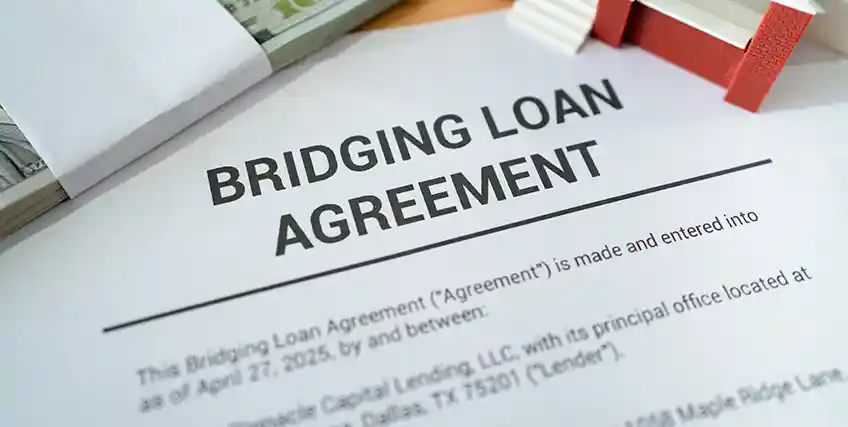Business Bridge Loans:
Fast Funding to Keep Operations Moving
Looking for Business Financing?
Apply now for flexible business financing. Biz2Credit offers term loans, revenue-based financing, lines of credit, and commercial real estate loans to qualified businesses.
Set up a Biz2Credit account and apply for business financing.
A bridge loan is a short-term financing solution used by businesses to manage temporary cash flow gaps. Whether you're purchasing equipment, waiting on invoice payments, or in the middle of refinancing, this loan type can provide immediate capital.
What makes a business bridge loan attractive is its speed and flexibility. While traditional loans may take weeks, bridge financing can arrive within days, giving you a competitive edge when timing matters. However, this speed often comes with higher interest rates and stricter repayment terms.
Businesses in real estate, construction, retail, and services often turn to bridge loans to maintain momentum when major transactions are pending. Understanding the costs, risks, and qualification process is critical before applying.
What is a Bridge Loan?
A bridge loan is a short-term loan designed to “bridge” a temporary gap between business expenses and incoming revenue or longer-term financing. It’s typically used to keep operations going during critical transitions—such as acquiring property, upgrading inventory, or covering costs until a major client payment clears.
Unlike a traditional term loan, a business bridge loan offers quicker access to funds with shorter repayment timelines, usually 6 to 18 months. Most bridge loans are backed by collateral like real estate or equipment. In return, lenders may offer interest-only terms, though these usually come at a higher interest rate than conventional loans.
Bridge financing is common among growing businesses or those managing large projects that require flexible working capital. It’s also frequently used during refinancing, when companies wait for longer-term loans or SBA 7(a) disbursements to come through.
How Does a Bridge Loan Work?
Here’s how a bridge loan works in a business context.
You apply for a short-term loan to cover an immediate expense - say, buying inventory or managing payroll. The lender reviews your credit score, loan-to-value ratio (LTV), and overall credit history. Once approved, funds are usually disbursed quickly.
Most bridge loans are interest-only for the duration, with a lump-sum repayment due at the end. This structure allows you to preserve working capital until your expected income arrives - whether that’s from closing a real estate deal, receiving a contract payment, or getting approved for a conventional mortgage.
The bridge loan amount you receive depends on the value of your collateral, your debt-to-income ratio, and your business’s cash flow. Some lenders may also charge origination fees, closing costs, and prepayment penalties.
In summary, bridge loans offer fast access to capital for urgent business needs, but only if you have a clear exit strategy.
When to Use a Business Bridge Loan
A bridge loan can be a strategic tool when your business needs immediate funding to seize opportunities or manage shortfalls. Here are key situations where using bridge financing makes sense:
01 While Awaiting Long-Term Financing
Businesses often apply for a bridge loan while waiting for a conventional mortgage or SBA 7(a) loan to be approved. These longer-term options can take weeks or months to finalize, which is risky when you’re under time pressure. A bridge loan provides the capital needed to move forward with property acquisitions, expansion, or renovations, without delays. Once the permanent financing kicks in, the bridge loan is repaid.
This form of short-term financing is commonly used in real estate transactions, especially when closing deadlines are tight
02 Managing Seasonal Cash Flow Gaps
Retailers, service providers, and manufacturers with seasonal business cycles often face cash flow gaps. During off-peak seasons, you may still need to pay staff, order supplies, or maintain operations. A bridge loan helps fill this temporary financial gap.
It acts as a financing option that maintains business continuity until seasonal revenue returns. Lenders often assess credit history and projected income when issuing a bridge loan in these cases.
This is especially valuable for businesses where predictable sales cycles and delayed customer payments are common.
03 Seizing Time-Sensitive Business Opportunities
Opportunities don’t wait for slow-moving funding. If you find discounted inventory, urgent real estate, or new contracts, you need fast capital to act. A commercial bridge loan lets you move quickly.
With quick underwriting and flexible approval processes, bridge loans offer the agility needed to compete. This is crucial in competitive industries like logistics, construction, and e-commerce.
Using this short-term loan, you can secure what you need today and pay it back once your expected income or funding arrives.
04 Delays in Customer or Contract Payments
Many B2B businesses operate on 30-to-90-day receivable cycles. Delays in invoice payments can choke your cash flow, even when your books look healthy. A bridge loan helps you cover expenses during this waiting period.
This form of bridge financing supports smooth operations while your receivables catch up. It’s particularly helpful for consulting firms, marketing agencies, and contractors dependent on milestone-based payments.
If your business has good receivables, solid contracts, and a clear repayment plan, this is a strong case for using bridge loan capital.
Pros and Cons of Business Bridge Loans
A bridge loan is a high-speed solution, but it comes with trade-offs. Below are key advantages and disadvantages to help you assess whether this short-term financing option aligns with your business needs.
Pros of Bridge Loans
Fast Access to Capital
When time is critical, bridge loans offer immediate funds—often within days of approval. Businesses facing closing deadlines, supplier payments, or urgent project needs, benefit from this speed.
Unlike long-term financing options, a bridge loan doesn't get stuck in lengthy underwriting processes. This helps avoid disruptions and maintain growth momentum.
Especially for those in commercial real estate, construction, or equipment-heavy industries, speed can make or break a deal. Bridge loans are built for these exact situations.
Interest-Only Payment Structure
Many bridge loan structures are interest-only, which helps reduce monthly payments during the short loan period. This keeps more capital in your hands to manage ongoing operations or execute business plans.
Instead of a full repayment schedule like a conventional mortgage, interest-only payments reduce strain until your permanent financing kicks in or receivables clear.
This structure gives more breathing room to businesses facing temporary cash flow shortfalls, especially during transitions like refinancing or asset upgrades.
Strategic Flexibility
A commercial bridge loan isn’t limited to a single purpose. Businesses can use the funds for payroll, inventory, property acquisition, or contract fulfillment. This makes it one of the more versatile forms of bridge financing.
Lenders are usually more focused on your ability to exit the loan - via future income or refinancing -rather than placing restrictions on how funds are deployed.
If your business has clear revenue expectations or asset-backed timelines, the flexibility of a bridge loan can give you a competitive edge.
Cons of Bridge Loans
Higher Interest Rates
Speed and convenience come at a cost. Bridging loan interest rates are typically higher than those for SBA loans or traditional term loans. Rates often range from 8% to 20% depending on your credit score, ltv, and collateral.
These bridging finance rates can quickly add up, especially for businesses that don’t repay on time. The cost of interest and origination fees may outweigh the benefit if not strategically used.
Businesses must factor in whether the short-term benefit is worth the longer-term financial burden.
Short Repayment Period
A bridge loan typically comes with a 6 to 18-month repayment window. That’s fast, and if your revenue doesn’t arrive as expected, you could run into trouble.
This tight window can create risk, especially for businesses without predictable cash inflow or firm financing commitments. The risk increases when real estate sales, asset liquidations, or refinancing take longer than planned.
If you’re unsure of your repayment timeline, a longer-term option may be a better fit.
Collateral May Be Required
Most bridge loans require strong collateral such as real estate, equipment, or business assets. Lenders use this to minimize risk due to the higher interest rates and shorter terms.
If you’re unable to repay the loan on time, your business could lose essential assets. For smaller or newer companies without a solid credit history, qualifying can be challenging.
This makes bridge loans less ideal for businesses that don’t own significant assets or lack a reliable exit strategy.
Pros |
Cons |
01 Fast decision and funding |
01 Higher interest rates |
02 Interest-only payments |
02 Short repayment period |
03 Flexible use of funds |
03 Collateral typically required |
04 Ideal for time-sensitive deals |
04 Risk if exit strategy is unclear |
Business Bridge Loan Costs Explained
Understanding the cost of a bridge loan is essential for any business decision. From bridging loan interest rates to hidden fees, here’s what you need to know.
Interest Rates
A key cost factor is the bridging loan interest rate. These rates typically range from 8% to 20%, depending on your credit score, loan-to-value ratio (LTV), and the strength of your business’s financials.
Compared to long-term financing, bridge financing rates are significantly higher. Lenders charge more due to the short duration and higher risk. Borrowers should weigh this against potential gains from using the funds quickly—like winning contracts or buying discounted assets.
If you’re considering a bridge loan, factor in the total interest cost over the loan’s life to understand its true impact.
Origination Fees
Most lenders charge origination fees for processing your bridge loan. These fees usually range from 1% to 4% of the loan amount, depending on the lender and the complexity of the loan.
While this may seem small, it adds to your upfront cost. If you're borrowing $200,000, a 2% origination fee equals $4,000 paid at closing. This doesn’t include interest-only payments and other expenses.
Always ask for a clear breakdown of origination charges before committing to any bridge loan product.
Closing Costs
Just like with real estate deals, a commercial bridge loan often comes with closing costs. These may include appraisal fees, legal documentation, and underwriting charges.
Depending on your lender, closing costs can add another 2% to 5% to your total borrowing expense. While some lenders may bundle these into the loan, others require upfront payment.
These costs can be particularly high in real estate or equipment-based bridge lending, where asset valuation is required. Always calculate this as part of your cost-per-dollar-funded when comparing financing options.
Monthly Payments and Balloon Payment
Most bridge loans offer interest-only monthly payments during the loan term. This makes them more manageable short term, as you're not repaying principal right away.
However, at the end of the loan term, a balloon payment is typically due. This lump sum includes the full principal and any unpaid fees. You’ll need to repay this through incoming revenue, sale of assets, or a refinancing plan.
If your business is not ready for this final payment, the cost can escalate with penalties or refinancing challenges.
Penalties and Prepayment Clauses
Some bridge loans come with penalties if you repay too early or too late. Prepayment penalties are less common but still exist with some lenders to recoup lost interest.
Late payments can trigger fees and may impact your credit history. Always review the fine print to ensure you know when and how you can pay without penalties.
Understanding your repayment timeline, cash flow, and revenue cycle is key to avoiding surprises.
Bridge Loan vs Long-Term Business Financing
Choosing between a bridge loan and long-term financing depends on how fast you need funds, how much you can afford in repayment, and what your exit strategy looks like.
A bridge loan is best when speed is critical. If you’re closing a real estate deal, need urgent inventory, or covering expenses while waiting for a large payment or loan, bridge financing is your go-to option. Funds arrive fast—often within a few days—and repayment happens over 6 to 18 months.
However, this speed comes with higher interest rates, origination fees, and a short repayment cycle. It works best when you have guaranteed cash flow incoming, such as a contract or refinancing in process.
In contrast, long-term financing like an SBA 7(a) loan, equipment loan, or conventional mortgage offers much lower rates (often below 10%) and longer repayment timelines—up to 25 years in some cases. But the trade-off is a slow, documentation-heavy process and stricter eligibility.
If you’re dealing with short-term cash gaps and have an exit strategy, a bridge loan gives you flexibility. If your business needs stability over time, long-term loans may be safer.
Who Qualifies for a Business Bridge Loan?
A bridge loan offers quick capital, but not everyone qualifies. Lenders need assurance that you can repay within the short window. Below are key factors that influence eligibility:
Strong Credit Score and History
Your credit score and credit history play a big role in approval. Most lenders prefer scores above 660, though some may approve lower scores with solid collateral.
A good credit profile shows you can manage monthly payments and handle repayment obligations. If your business has past defaults, bankruptcies, or inconsistent credit behavior, your chances may drop—or your bridging loan interest rate may increase.
Lenders also assess your business credit, including payment history to vendors and other financial institutions.
Clear Exit Strategy
Lenders want to know how you’ll repay the bridge loan. Common strategies include refinancing through SBA or term loans, incoming contract payments, or asset sales.
A strong exit plan lowers the lender’s risk and boosts your approval odds. Without it, even businesses with good revenue may face rejection.
You’ll be asked to explain timelines, documents backing your future inflows, and your debt-to-income ratio. Be prepared with proof that you can settle the loan amount before maturity.
Stable Cash Flow and Profitability
Cash flow consistency shows you can afford interest-only payments and operate without financial stress. Lenders review recent bank statements, balance sheets, and profit & loss reports to evaluate risk.
Even though bridge loans are short term, they need assurance that your business won’t falter mid-way. This is especially critical if your bridge financing spans multiple months.
Companies in fast-moving sectors like e-commerce, logistics, and construction, often meet this requirement due to ongoing project-based income.
Collateral or Asset Backing
Many commercial bridge loan approvals depend on assets like real estate, equipment, or high-value inventory. These reduce risk for lenders and increase your borrowing potential.
The loan-to-value ratio (LTV) of the asset impacts how much you can borrow. A low LTV (under 70%) is usually preferred. If the asset has resale value, lenders may be more flexible on other criteria like credit score.
If you're applying for an unsecured bridge loan, expect higher bridging finance rates and stricter underwriting.
Alternatives to a Business Bridge Loan
While a bridge loan is fast and flexible, it’s not always the best fit for every business. Below are alternatives worth considering, depending on your needs, cost tolerance, and cash flow situation:
Business Line of Credit
A business line of credit gives you flexible access to capital when you need it. You only pay interest on the amount you use, which is great for managing short-term financing gaps or unexpected expenses.
Compared to a bridge loan, it’s more affordable but slower to secure, especially if you’re a first-time applicant. Lines of credit are ideal for recurring needs like payroll, marketing, or seasonal inventory.
If your business has a decent credit history and steady income, this can be a strong alternative to bridge financing with lower monthly payments and longer usage timelines.
Invoice Financing
If delayed customer payments are choking your cash flow, invoice financing is a smart route. Instead of waiting 30, 60, or 90 days, you can get immediate funds based on unpaid invoices.
This isn’t technically a loan. It’s an advance on receivables. You maintain control while accessing cash without adding debt to your books.
Unlike a bridge loan, no collateral is required, and repayment happens automatically as invoices are paid. It’s particularly useful for service businesses, consultants, and contractors who deal with milestone payments.
SBA Express Loans
The SBA Express Loan is a federally backed program offering up to $500,000 in fast-track loans. While it’s not as fast as a bridge loan, it’s quicker than traditional SBA options, funds can arrive in 36 hours after approval.
It’s a good fit if you have time to apply and want more favorable terms. Interest rates are lower, and repayment terms are more forgiving.
The loan requires decent credit history, but it’s a solid option if your business has a plan and prefers government-backed programs over high-rate commercial bridge loans.
Equipment Financing
Need to upgrade machinery, vehicles, or hardware? Equipment loans are ideal for these targeted needs. You’ll usually get lower interest rates than a bridge loan, with terms up to 5–7 years.
The equipment itself serves as collateral, so credit score requirements may be lighter. Monthly payments are predictable, and the approval process is streamlined for asset-backed lending.
If you’re considering using a bridge loan to buy or lease equipment, compare costs—this method might save thousands in interest-only payments and closing costs.
Trusted by Thousands of Small Business Owners in America.**
Simply because we get what you go through to build a business you believe in.
**Disclaimer: All stories are real, as told by real business owners. Customers do not receive monetary compensation for telling their stories.
From One Entrepreneur to Another: We Get You
We understand what's behind building a business you believe in.
All stories are real, as told by real business owners. Customers do not receive monetary compensation for telling their stories.



Articles on Small Business Bridge Loans
How Bridge Loans Help Entrepreneurs Quickly Secure a Small Business Purchase
Buying a business isn’t just about the right asking price. It’s also about timing. Entrepreneurs often find themselves competing with
Hard Money vs. Bridge Loans What’s the Best Option for Real Estate Investing
Apart from traditional mortgages, you can also choose from asset-based loans, such as bridge loans and hard money loans
Bridge Loans for Real Estate: A Short-Term Funding Guide
In competitive markets where desirable commercial properties are scooped up within days, business owners can’t afford
Need Cash in 48 Hours? Fast Bridging Loans Could Be the Answer
Most startup owners understand the importance of selecting the right business credit card for new businesses. It's more than just swiping a card.
Why Bridge Financing in Real Estate Might Be Your Best Bet in 2025
The real estate market in 2025 is moving at full speed. Buyers are acting fast, and properties are closing quicker than ever. With this speed
FAQs Business Loans With Bad Credit
1. What is a business bridge loan used for?
A bridge loan is typically used to cover immediate expenses like payroll, inventory, or real estate purchases while waiting for long-term financing or receivables. It’s a short-term loan that helps maintain operations during financial gaps.
2. Are bridging loan interest rates higher than regular loans?
Bridging loan interest rates are usually higher than SBA or term loans. Rates may range on the higher side, reflecting the loan's short duration and higher risk. Always compare with other financing options.
3. Can startups apply for a business bridge loan?
Startups can apply for a bridge loan, but approval is tougher without strong cash flow or collateral. Lenders look at credit history, revenue potential, and exit strategy before approving new businesses.
4. Do bridge loans require monthly payments?
Most bridge loans offer interest-only monthly payments during the term. A lump-sum (balloon) repayment is usually due at the end. This structure helps with cash flow, but planning for the final payout is critical.
5. Is real estate always needed as collateral for a bridge loan?
Commercial bridge loans often require real estate or equipment as collateral. Businesses without assets may still qualify but face higher interest rates or smaller loan amounts.





